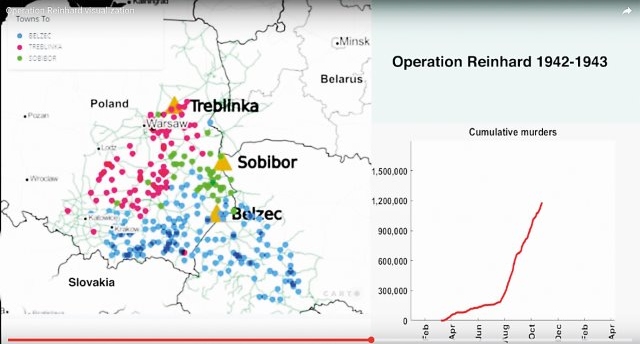click to dowload our latest edition
CLICK HERE TO SUBSCRIBE TO OUR NEWSLETTER


Published
5 years agoon
By
adminELSABE BRITS
A study done by Lewi Stone, Professor of Biomathematics at Tel Aviv University and RMIT University in Melbourne, has been published in the peer review journal Science Advances.
Operation Reinhard (1942–1943) was the largest single murder campaign of the Holocaust, during which about 1.7 million Jews from German-occupied Poland were murdered by the Nazis. But the shocking scale and rate of this operation has been revealed by Stone, a mathematical biologist. He used spatiotemporal visualisation, data, and mathematics to plot genocidal events.
Most victims of this operation perished in gas chambers at the death camps Belzec, Sobibor, and Treblinka. However, the tempo, “kill rates”, and spatial dynamics of these events were poorly documented, until now.
Using an unusual dataset originating from railway transportation records, this study identifies an extreme phase of the hyper intense killing of about 1.47 million Jews. Therefore, more than 25% of the Jews killed in all the six years of World War II, were murdered by the Nazis in an intense 100-day surge.
Stone’s analysis was based on carefully compiled train records presented in a book (1987) by Professor Yitzhak Arad, a well-known Holocaust historian and former director of Yad Vashem. It showed about 500 train transportations from 400 different Polish Jewish communities.
The study identified a “kill rate”, using data science and visualisation, of extreme magnitude almost twice as high as the Rwanda genocide, and a Holocaust death number roughly 10 times higher than commonly believed.
Using Arad’s data, Stone estimated the rate at which the Nazis killed Jews during Operation Reinhard, showing that most of the murders occurred in just three months – August, September, and October 1942. On average 450 000 victims were killed each month. Of the 1.7 million victims of Operation Reinhard, about 1.5 million, were murdered during these three months. About 15 000 murders per day, every day.
“The operation began in March 1942 and lasted 21 months, concluding in November 1943. In this operation, the three key death camps, Belzec, Sobibor, and Treblinka, were set up with the intention of eliminating every Jew in German-occupied Poland, the region known as the General Government (GG).
“Detailed records of the killings are almost non-existent because of the Nazis’ tight secrecy around Operation Reinhard. Any information that was recorded was deliberately burnt and destroyed by the Nazis during the war for fear of future incrimination. In addition, a large percentage of murders have to be attributed to widespread shooting, since a ‘Holocaust by bullets’ took place in parallel both in and outside the GG.
“Because Auschwitz has long been viewed as the central symbol of the Holocaust, the Reinhard death camps have received relatively less attention for many years. While Auschwitz had a reasonable number of survivors to reconstruct history, very few survived the camps of Operation Reinhard to convey their experiences,” Stone writes in the study.
The Deutsche Reichsbahn, the German National Railway, played a critical role in transporting millions of Jewish victims to the death camps, and the “special trains” that transported the victims were kept on strict time schedules. The railway employed almost half a million civil servants and 900 000 workers, and knowingly participated in the killings, according to the study.
Compared to the 1994 Rwanda genocide, which has been suggested as the most intense genocide of the 20th century, the murder rate during Operation Reinhard was 83% higher, according to Stone. He views comparisons of genocides – which has become popular – as distasteful.
Stone estimates that the Nazis’ murder campaign could have continued at this pace had there been more victims living in German-occupied Poland, but instead the murder rate tapered off in November 1942.
There was essentially no one left to kill, he says. It could have continued, but the shocking truth is the majority of Jews in Poland were dead.
The Nazi agenda was then revised to transport and murder the remaining Jewish populations of Europe to the Auschwitz-Birkenau extermination facility. Auschwitz was operating on a continual basis from 1941, but had exceptionally high “kill rates” in 1944, according to the study.
Stone says especially when comparing modern genocides, historians, social scientists, policy-makers, and journalists have consistently relied on inaccurate assessments that greatly underestimated the Holocaust “kill rate” during Operation Reinhard.
“These underestimates have been repeated for nearly two decades without substantial criticism, a pattern that has effectively rewritten the history of the Holocaust in a way that diminishes its historical standing and the scale of human life it encompasses.
“These underestimates have arisen and persisted because of a lack of awareness of the details concerning the Reinhard death camps, and the effectiveness of the Nazi efforts to obscure those details during the war. Our analyses shed new light on this period of the Holocaust and provide a clearer and detailed picture of the dynamics and rates of the major events as they unfolded during Operation Reinhard.”
Why does this matter?
“The Holocaust stands out as a demonstration of how the efficient machinery of government was turned on people in an unparalleled way. It transcended in its ruthlessness and systemic efficiency. This is the key lesson of the Holocaust that I believe must not be forgotten,” Stone said in a release from RMIT University.
“The power of graphing more specific data helps us to understand the co-ordination involved by a state machinery responsive to the Führer’s murderous will, and the necessity of large-scale organised support to carry out the murders: train routing of hundreds or whole communities, administration staff, and complex logistics networks at a time when Germany’s resources were stretched by the war effort.”
But this research also highlights the magnitude of the intensity of killing during the Holocaust, in spite of that being called into question in recent decades, says Stone.
